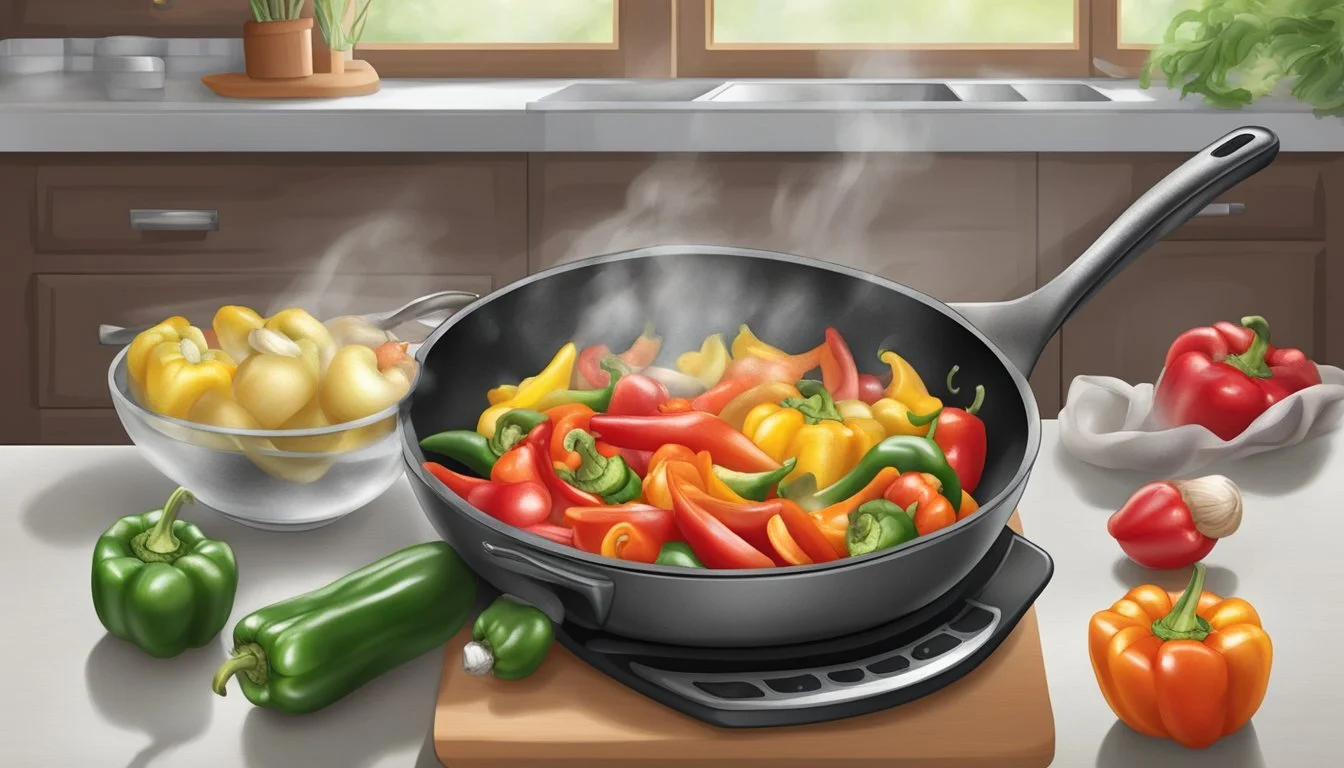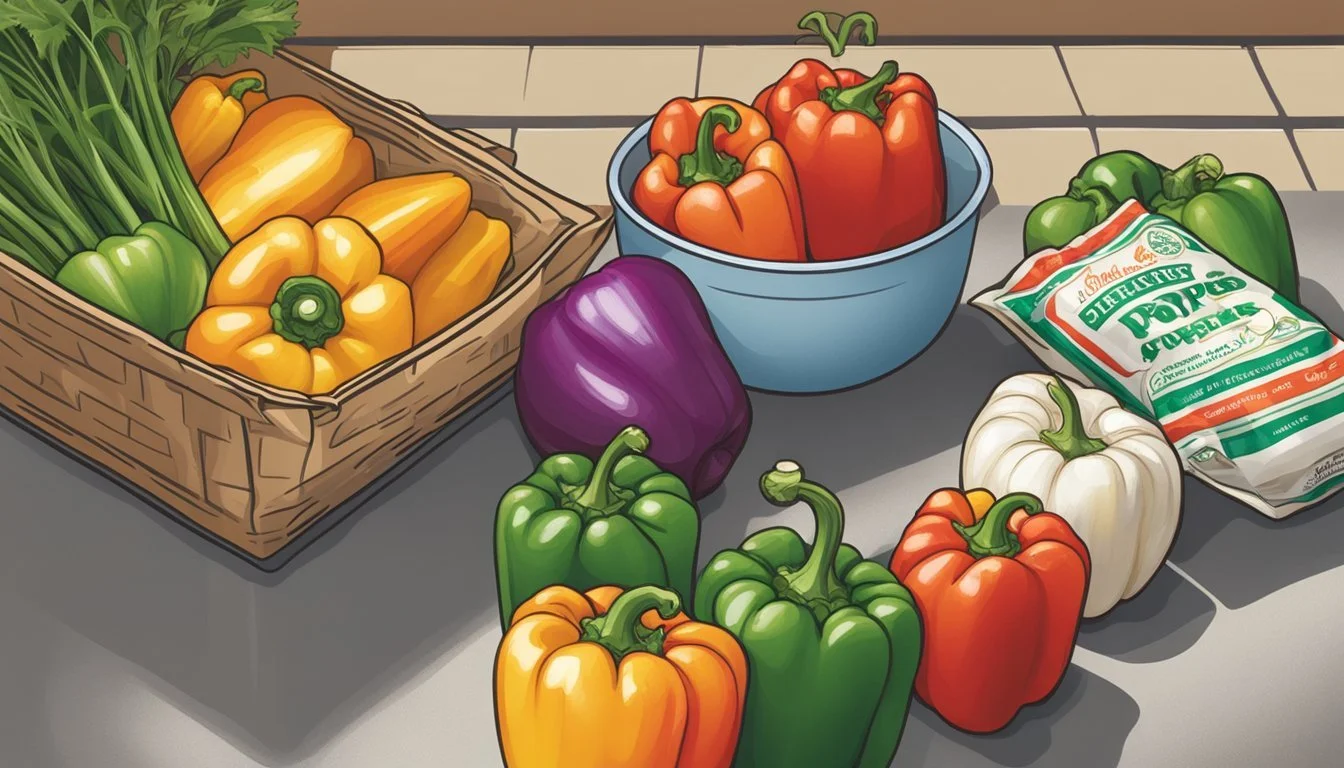Frozen Peppers and Onions vs Fresh: Comparing Convenience and Flavor
Frozen peppers and onions offer a convenient alternative to fresh produce, providing quick and easy meal solutions for busy home cooks. These frozen vegetables retain much of their nutritional value and flavor, making them a practical choice for many dishes.
Studies have shown that frozen vegetables can be just as nutritious as their fresh counterparts, and in some cases, may even score higher in nutrient content. This is because freezing preserves the vegetables at their peak freshness, locking in vitamins and minerals that might otherwise degrade during transport and storage of fresh produce.
Cooking with frozen peppers and onions is simple and versatile. They can be roasted in the oven, sautéed on the stovetop, or added directly to stir-fries, soups, and stews. With proper preparation, these frozen vegetables can achieve a tender texture and caramelized flavor similar to fresh-cooked options, making them a valuable ingredient in any kitchen.
Nutritional Comparison of Frozen and Fresh Peppers and Onions
Frozen and fresh peppers and onions both offer excellent nutritional value. Studies have shown that the nutrient content can be quite similar between the two forms.
Peppers and onions are rich sources of vitamins and minerals. They contain vitamin C, vitamin A, and various antioxidants. The freezing process helps preserve many of these nutrients.
Vitamin C content may decrease slightly in frozen vegetables over time. However, frozen peppers and onions can still provide a significant amount of this important water-soluble vitamin.
Carotenoids, which give peppers their vibrant colors, are generally well-preserved during freezing. These compounds act as antioxidants in the body.
Minerals like potassium and magnesium remain stable whether the vegetables are fresh or frozen. These elements play crucial roles in various bodily functions.
Some nutrients may be more bioavailable in cooked frozen vegetables compared to raw fresh ones. The freezing and thawing process can break down cell walls, potentially increasing nutrient absorption.
Frozen peppers and onions offer convenience without sacrificing nutritional quality. They provide a reliable way to incorporate these vegetables into meals year-round.
The Impact of Preparation and Storage on Quality
Proper handling of frozen peppers and onions significantly affects their quality. Thawing methods, moisture management, and storage techniques all play crucial roles in maintaining flavor, texture, and nutritional value.
Thawing and Moisture Content
Frozen peppers and onions contain ice crystals that can affect texture upon thawing. To minimize moisture loss, thaw frozen vegetables in the refrigerator overnight. This slow thawing helps retain cellular structure and prevents excess water release.
For quicker thawing, place frozen peppers and onions in a colander and run cool water over them. Drain thoroughly to remove excess moisture before cooking.
Microwaving is not recommended for thawing, as it can lead to uneven heating and texture changes.
Shelf Life Considerations
Frozen peppers and onions typically have a longer shelf life than fresh varieties. When stored properly, they can maintain quality for 8-12 months in the freezer.
Fresh peppers and onions last about 1-2 weeks in the refrigerator. Their shelf life depends on factors like ripeness at purchase and storage conditions.
Frozen produce retains most of its nutritional value due to minimal processing and quick freezing after harvest.
Proper Storage Techniques
Store frozen peppers and onions in airtight containers or freezer bags to prevent freezer burn. Remove as much air as possible from packaging to minimize ice crystal formation.
Keep frozen vegetables at a constant temperature of 0°F (-18°C) or below. Avoid frequent temperature fluctuations, which can lead to quality degradation.
For fresh peppers and onions, store them in the refrigerator's crisper drawer. Place them in perforated plastic bags to allow air circulation and prevent excess moisture buildup.
Regularly check stored produce for signs of spoilage, such as mold or soft spots. Discard any items showing these signs to prevent contamination of other produce.
Culinary Uses and Techniques
Frozen peppers and onions offer versatile options for cooking, allowing for quick meal preparation while maintaining flavor and nutritional value. These convenient ingredients can be easily incorporated into various dishes using different cooking methods.
Cooking with Frozen Peppers and Onions
Sautéing frozen peppers and onions is a popular technique. Heat a skillet over medium heat, add olive oil, and cook the vegetables for 5-7 minutes until tender. Stir occasionally to prevent sticking and ensure even cooking.
Roasting is another effective method. Preheat the oven to 400°F (200°C). Spread the frozen vegetables on a baking sheet lined with cooking spray. Roast for 15-20 minutes, stirring halfway through, until they caramelize and develop a rich flavor.
For stir-fries, add frozen peppers and onions directly to the hot pan with other ingredients. Cook over high heat, stirring constantly, until excess moisture evaporates and vegetables are crisp-tender.
Achieving Desired Flavors and Textures
To enhance flavor, season frozen peppers and onions with salt, pepper, and garlic powder before cooking. Adding herbs like thyme or oregano can provide additional depth.
For a crisp texture, avoid overcrowding the pan when sautéing or stir-frying. Cook in batches if necessary to prevent steaming.
To achieve a softer texture, cover the skillet while cooking or add a small amount of liquid like broth or wine. This creates steam, helping to tenderize the vegetables.
Roasting at high temperatures can bring out natural sweetness and create slightly charred edges for added complexity.
Creative Ways to Incorporate into Dishes
Frozen peppers and onions are excellent additions to omelets and frittatas. Simply sauté them briefly before adding eggs for a quick breakfast option.
Use these vegetables as a base for hearty soups and stews. Add them directly to the pot with other ingredients and simmer until tender.
For fajitas, cook frozen peppers and onions in a hot skillet with fajita seasoning. Serve with warm tortillas, protein of choice, and toppings.
Blend thawed peppers and onions into pasta sauces or use as pizza toppings for added flavor and nutrition.
Incorporate them into casseroles, quiches, or rice dishes for convenient one-pot meals.
Comparing Cooking Times and Convenience
Frozen and fresh peppers and onions differ in their preparation and cooking processes. These differences impact both home cooks and professional chefs in various ways.
Frozen Vs. Fresh Cooking Timelines
Frozen peppers and onions generally have shorter cooking times compared to their fresh counterparts. Fresh vegetables require washing, peeling, and chopping before cooking. Frozen options come pre-cut and ready to use.
Cooking frozen peppers and onions typically takes 5-10 minutes in a skillet over medium heat. Fresh vegetables may need 10-15 minutes to achieve the same level of tenderness.
Roasting frozen peppers and onions in the oven at 400°F takes about 20-25 minutes. Fresh vegetables might require 30-35 minutes for similar results.
Convenience for Home Cooks
Frozen peppers and onions offer significant convenience for home cooks. They eliminate prep time and reduce food waste. These pre-cut vegetables can be stored in the freezer for months, ensuring availability whenever needed.
Using frozen options allows for more consistent portion control. Home cooks can easily measure out exact quantities without leftover ingredients.
Fresh peppers and onions provide flexibility in cutting styles and sizes. They also offer a satisfying tactile experience for those who enjoy hands-on cooking.
Professional Chefs' Perspectives
Professional chefs often prefer fresh peppers and onions for their superior texture and flavor. Fresh produce allows for more control over the final dish's taste and appearance.
Some chefs use frozen options for cost-effective bulk cooking or as backup ingredients. Frozen peppers and onions ensure consistent quality regardless of seasonal availability.
In high-volume kitchens, frozen vegetables can streamline food preparation processes. They reduce labor costs associated with washing, peeling, and chopping fresh produce.
Chefs may combine fresh and frozen ingredients to balance flavor, texture, and efficiency in their recipes.
Comparative Taste Profiles
Frozen and fresh peppers and onions offer distinct flavor experiences. Their taste profiles are influenced by various factors, from processing methods to preparation techniques.
Freshness and Ripeness Effects
Fresh peppers and onions provide vibrant, crisp flavors. Ripe peppers offer sweetness, while fresh onions deliver a sharp, pungent taste. The texture of fresh produce is typically firmer and more satisfying to bite into.
Ripeness plays a crucial role in taste intensity. Fully ripe peppers are sweeter and more aromatic. Onions develop a milder flavor as they mature.
Fresh produce allows for greater control over ripeness selection. This enables choosing the ideal flavor profile for specific dishes.
Impact of Freezing on Taste
Freezing affects the taste and texture of peppers and onions. The process can slightly mute flavors and soften textures.
Frozen vegetables often retain more nutrients than fresh ones stored for extended periods. This can contribute to a fuller flavor profile.
Freezing can intensify certain tastes. Onions may become slightly sweeter after freezing due to the breakdown of complex sugars.
Frozen peppers and onions are convenient for achieving a caramelized flavor quickly. They release moisture faster during cooking, speeding up the caramelization process.
Enhancing Flavor with Spices and Techniques
Both fresh and frozen peppers and onions benefit from proper seasoning. Garlic powder and paprika complement their natural flavors well.
Charring frozen peppers can add depth and smokiness. This technique compensates for any flavor loss during freezing.
Fresh produce responds well to slow-cooking methods, allowing flavors to develop fully. Frozen vegetables excel in quick-cooking techniques like stir-frying.
Marinating fresh peppers and onions before cooking can enhance their taste. For frozen varieties, adding spices during the cooking process helps infuse flavors effectively.
Combining fresh and frozen ingredients can create a balanced flavor profile. This approach maximizes the benefits of both options.
Health and Dietary Considerations
Frozen and fresh peppers and onions offer numerous health benefits. Their nutrient content, dietary advantages, and natural compounds play important roles in supporting overall wellbeing.
Comparing Nutrient Content After Cooking
Frozen peppers and onions often retain more nutrients than their fresh counterparts after cooking. This is because freezing occurs shortly after harvest, preserving vitamins and minerals. Fresh produce may lose some nutrients during transport and storage.
Vitamin C content in frozen peppers can be higher than in fresh ones stored for several days. Frozen onions maintain similar levels of flavonoids as fresh ones.
Cooking methods impact nutrient retention. Roasting or sautéing frozen peppers and onions can help preserve more vitamins compared to boiling.
Dietary Benefits of Peppers and Onions
Peppers and onions are low in calories and high in fiber, making them excellent choices for weight management. They provide essential vitamins and minerals.
Key nutrients in peppers:
Vitamin C
Vitamin A
Potassium
Folate
Key nutrients in onions:
Vitamin C
Vitamin B6
Folate
Potassium
Both vegetables are rich in antioxidants, which help protect cells from damage. Regular consumption may support heart health and reduce inflammation.
Natural Chemicals and Health Impact
Peppers contain capsaicin, a compound that gives them heat and may offer health benefits. Capsaicin has been linked to improved metabolism and reduced pain.
Onions are rich in organosulfur compounds and quercetin. These natural chemicals have potential anti-inflammatory and anti-cancer properties.
The allicin in onions may help lower blood pressure and cholesterol levels. Red and yellow peppers are high in beta-carotene, which supports eye health.
Both frozen and fresh peppers and onions provide these beneficial compounds. Proper storage and cooking methods help maximize their health-promoting effects.
Environmental and Seasonal Factors
Harvest timing and seasonality impact the quality and sustainability of frozen and fresh produce. Freezing methods allow year-round availability, while fresh options fluctuate with growing seasons.
Effects of Harvest and Season on Quality
Fresh produce quality varies based on harvest time and season. Fruits and vegetables picked at peak ripeness offer optimal flavor and nutrition. However, off-season fresh produce may travel long distances, reducing quality.
Frozen fruits and vegetables are typically harvested at peak ripeness and quickly processed. This locks in nutrients and flavor. Blanching before freezing helps preserve color and texture.
Season impacts fresh produce availability. Local, in-season fruits and vegetables provide the best fresh options. Frozen produce offers consistency year-round.
Sustainability of Frozen vs. Fresh Produce
Frozen produce can reduce food waste. It has a longer shelf life than fresh, allowing for bulk purchasing and storage. This may decrease packaging and transportation needs over time.
Fresh produce often requires more frequent trips to the store. Local, seasonal fruits and vegetables have a lower carbon footprint. However, off-season fresh produce may travel far distances.
Freezing processes use energy and water resources. But frozen produce reduces waste at stores and in homes. Neither option is definitively more sustainable in all cases.
Chemical use varies for both frozen and fresh. Organic options exist for both types. Proper storage and handling are key for food safety with fresh and frozen produce.
Versatility in Recipes and Pairings
Frozen and fresh peppers and onions offer diverse culinary applications, adapting well to various dishes and ingredient combinations. Their versatility extends from quick weeknight meals to elaborate gourmet creations.
Ideal Dishes for Frozen and Fresh Varieties
Frozen peppers and onions excel in stews, soups, and pasta dishes. They maintain texture and flavor when cooked slowly, making them perfect for hearty winter meals. Toss them into chili for added depth or use in quick stir-fries for convenient weeknight dinners.
Fresh peppers and onions shine in sandwiches, salads, and salsas. Their crisp texture and vibrant flavors elevate these dishes. Grilled fresh peppers and onions make an excellent side dish for barbecues.
Both frozen and fresh varieties work well in omelets, quiches, and frittatas. They add color, texture, and flavor to these egg-based dishes.
Complementary Ingredients for Flavor
Peppers and onions pair beautifully with a range of ingredients. Tomatoes complement their flavors in sauces and salsas. Garlic enhances their savory notes in sautés and stir-fries.
For Mexican-inspired dishes, combine peppers and onions with cilantro, cumin, and chili powder. This blend works well in fajitas, tacos, and enchiladas.
In Italian cuisine, pair them with basil, oregano, and olive oil for a classic flavor profile. This combination excels in pasta sauces and on pizzas.
For added texture and nutrition, mix peppers and onions with other vegetables:
Carrots
Peas
Corn
Green beans
Spinach
These pairings create well-rounded side dishes or hearty vegetable medleys.
Practical Tips for Cooking and Serving
Mastering the use of frozen peppers and onions can elevate your culinary creations. These tips will help you avoid common pitfalls and present your dishes with flair.
Avoiding Common Cooking Mistakes
Avoid overcrowding the pan when cooking frozen peppers and onions. This can lead to steaming rather than sautéing, resulting in a mushy texture. Use a large skillet or cook in batches for best results.
Thaw frozen vegetables in a colander before cooking to drain excess moisture. This prevents diluting flavors and ensures crisp textures in stir-fries and omelets.
For soups and stews, add frozen peppers and onions directly to the pot. The slow cooking process allows them to thaw and release flavors gradually.
When roasting, spread frozen vegetables in a single layer on a baking sheet. This promotes even cooking and caramelization.
Serving Suggestions and Presentation
Combine colorful peppers with frozen onions for visually appealing stir-fries. Add them to scrambled eggs for a quick, nutritious breakfast.
Create vibrant side dishes by mixing sautéed frozen peppers and onions with other frozen vegetables like broccoli. This adds variety to your plate.
For a refreshing twist, pair cooked peppers and onions with fresh fruits like apples or berries in salads. The contrast in textures and flavors can be delightful.
Present your dishes on colorful plates to enhance the visual appeal of the cooked vegetables. Garnish with fresh herbs for added aroma and presentation.





